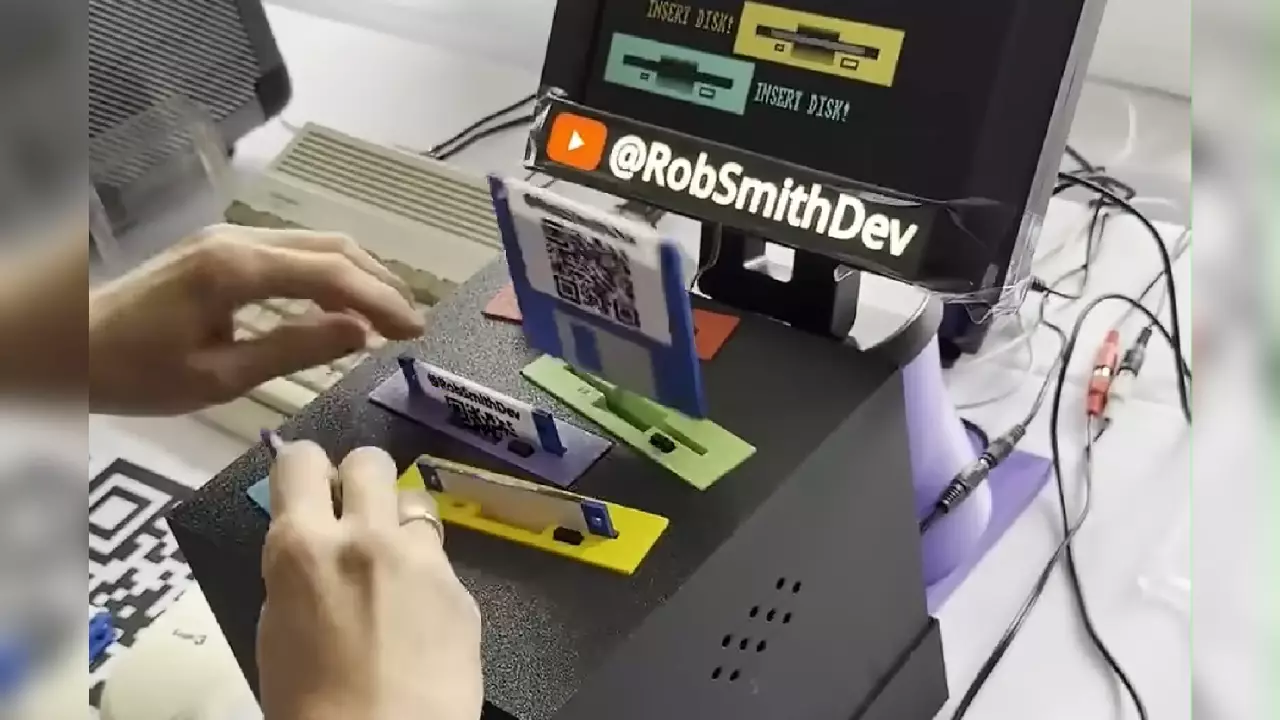In a digital world dominated by sleek, high-powered gaming consoles and instant streaming, the charm of vintage technology remains profoundly compelling. While I have never personally held a floppy disk—let alone navigated its insides—I can’t deny a fleeting pang of longing for the simplicity and tactile nature of those bygone days. This nostalgia fuels the inventive spirit of modern creators who seek to bridge the gap between the past and present. The recent project by Rob Smith Dev exemplifies this beautifully, transforming a retro icon—the floppy disk—into a dynamic, playful device that challenges conventional perceptions of old hardware.
Smith’s creation, “DiskFight,” is more than just a nostalgic homage; it’s an engineering marvel that combines hardware ingenuity and software artistry into a cohesive experience. By repurposing familiar tech, Smith demonstrates how inventive thinking can breathe new life into obsolete devices. The project underscores how nostalgia, when coupled with modern innovation, can serve as a powerful catalyst for creative expression and learning, encouraging enthusiasts to reimagine the capabilities of vintage components rather than consigning them to the realm of forgotten relics.
Engineering Challenges and Creative Solutions
One of the most striking aspects of Smith’s project lies in his use of custom-designed linear actuators. These tiny mechanical devices work beneath the floppy disks, applying just enough force to nudge the disks upward or allow them to bounce out of their slots. This subtle yet clever mechanism transforms a static storage device into an interactive game element. Instead of the traditional, passive role of floppy disks, they become engaging targets that require precision and timing to succeed.
This approach also highlights a core principle of inventive engineering: simplicity combined with clever design. Smith’s choice to create a mechanism that allows disks to be either easily pressed back in or gently lifted out sidesteps the need for complex robotics, keeping the project accessible while maximizing entertainment value. The physical construction—using 3D-printed parts, screws, and glue—further exemplifies how accessible fabrication techniques can enable hobbyists to push creative boundaries without reliance on expensive machinery. The effort put into designing this hardware demonstrates a thoughtful balance between technical complexity and user engagement.
However, critically analyzing this process reveals potential limitations. Custom components like linear actuators require precision manufacturing and calibration, which can be challenging for less experienced builders. Furthermore, the durability of such mechanisms might become a concern over extended use, especially with the fragile nature of floppy disks. Nonetheless, Smith’s methodical approach and iterative testing illustrate that even modest DIY setups can produce impressive results, inspiring others to experiment with their own retro projects.
Blending Software Innovation with Musical Nostalgia
Complementing the hardware side, the software development for DiskFight relied heavily on AMOS, a programming language specifically tailored for Amiga computers. This choice reflects a deep appreciation for retro computing environments, as AMOS enabled quick prototyping and game logic implementation within a nostalgic framework. The game’s code orchestrates disk movement, scoring, and timing—functions central to delivering an engaging experience in just thirty seconds.
Adding further depth, Smith collaborated with musician Hoffman to generate original soundtrack content, integrating a hi-energy drum and bass song titled “Disk Menace.” This piece, crafted with retro synthesizers and electronics, accentuates the game’s rising intensity, heightening player immersion. The use of authentic hardware to produce music underscores a profound respect for the Amiga’s legacy, affirming that sound design remains a vital component of nostalgic gaming.
Yet, from a critical standpoint, this fusion of software and music is not without its challenges. Ensuring that the soundtracks synchronize perfectly with gameplay moments demands meticulous timing, especially given the constraints of vintage hardware emulation. Additionally, the brevity of the game—only thirty seconds—raises questions about replayability and depth. While it’s evident that Smith isn’t aiming for a long, complex game, this limited scope might hinder sustained engagement beyond curiosity or nostalgia. Nevertheless, the artistic decisions—marrying hardware design with sound and software—demonstrate how modern creators can pay homage while adding their personal stamp to vintage tech.
Impact and Future Possibilities
Smith’s DiskFight exemplifies a broader trend of retro-tech revivalism, where enthusiasts push beyond mere preservation, actively reimagining what vintage devices can become. It champions a philosophy that outdated hardware is not obsolete but ripe for reinterpretation through creative engineering. This attitude challenges the often passive way we regard the past, advocating instead for hands-on exploration and inventive repurposing.
Such projects also inspire a new generation of makers, emphasizing that innovation need not be confined to the latest, flashiest technology. Instead, ingenuity can thrive in the intersections of old and new, hardware and software, nostalgia and novelty. As more hobbyists embrace these principles, we can expect a proliferation of unique creations that not only entertain but also educate—demonstrating how understanding vintage systems can inform modern design thinking.
Furthermore, DiskFight’s success in generating interest hints at potential future developments—more complex mechanics, expanded software features, or even community-driven modifications. By hacking their way into old tech, creators like Smith are fostering a culture that values experimentation and reimagining, proving that true innovation is timeless and boundless, regardless of technological age.

